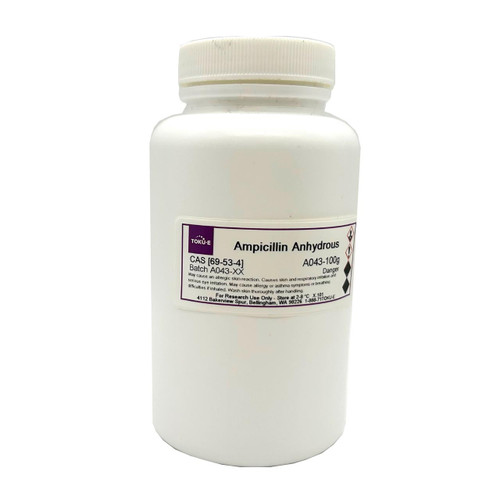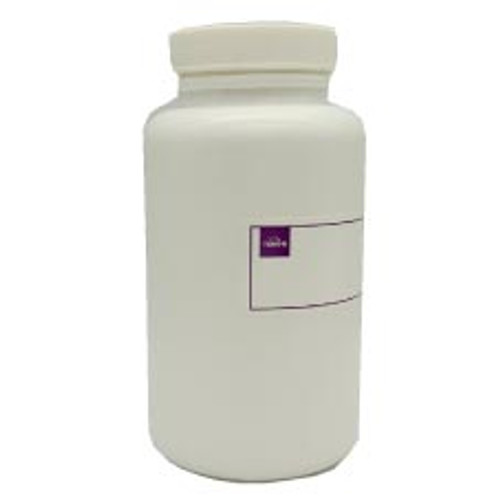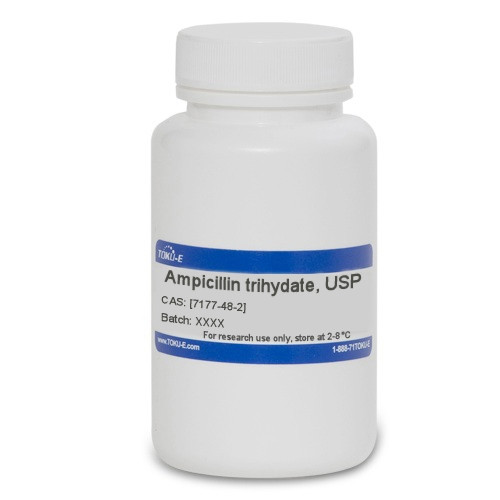Ampicillin Anhydrous is a member of the β-lactam family and is similar in structure to penicillin. Ampicillin Anhydrous is the most stable and pure form that we offer. It is sparingly soluble in water and soluble in 1 N NH4OH.
We also offer:
- Ampicillin Sodium (A042)
- Ampicillin/Sulbactam (2:1) (A071)
- Ampicillin Trihydrate, USP (A009)
- Ampicillin Trihydrate, EP (A020)
- Ampicillin ReadyMadeTM Solution (A228)
| Mechanism of Action | Like all β-lactams, Ampicillin interferes with PBP (penicillin binding protein) activity otherwise involved in the final phase of peptidoglycan synthesis. PBP’s are enzymes which catalyze a pentaglycine crosslink between alanine and lysine residues. Without a pentaglycine crosslink, the integrity of the cell wall is severely compromised ultimately leading to cell lysis. |
| Spectrum | Ampicillin targets Gram-negative, non ESBL (Extended Spectrum β-lactamase) bacteria including Staphylococcus and Streptococcus and medically important enteric pathogens such as Shigella and Salmonella. Interestingly, Ampicillin has been found to be effective against certain β-lactam sensitive VRE or vancomycin resistant Enterococcus; a glycopeptide antibiotic resistant "superbug." |
| Microbiology Applications | Ampicillin Anhydrous is often used to select for cells that have been transformed with a plasmid containing the ampR gene which confers resistance to Ampicillin. Ampicillin is typically used at a concentration of 50-100 µg/mL.
Media SupplementsAmpicillin Anhydrous can be used as a selective agent in several types of isolation media: Aeromonas Medium Base - Ampicililn Selective Supplement |
| Eukaryotic Cell Culture Applications | Ampicillin is routinely used to select for cells containing the pcDNA3.1 and pEAK10 resistance plasmids in cell line A904L at an effective concentration of 50 µg/mL. For additional information on your cell culture needs, please visit our cell-culture database. |
| Molecular Formula | C16H19N3O4S |
| Solubility | Sparingly soluble in water. Soluble in 1 N NH4OH (50 mg/mL) |
| References |
Pitout JD, Sanders CC, Sanders WE (1997) Antimicrobial resistance with focus on beta-lactam resistance in gram-negative bacilli. Am. J. Med 103(1):51-59 PMID 9236486 Waxman DJ and Strominger JL (1983) Penicillin-binding proteins and the mechanism of action of beta-lactam antibiotics. Ann. Rev. Biochem 52:825-869 PMID 6351730 Yang W, Zhang L, Lu Z, Tao W, Zhai Z (2001) A new method for protein coexpression in Escherichia coli using two incompatible plasmids. Protein. Expr. Purif. 22(3):472-478 PMID 11483011 |
| MIC | Diplococcus pneumoniae| 0.01 - 0.04| 1413| Haemophilus influenzae| 0.04 - 0.8| 1413| Neisseria gonorrhoeae (penicillin-resistant)| 4 - 128| 1408| Neisseria gonorrhoeae (penicillin-susceptible)| 0.008 - 0.25| 1408| Stenotrophomonas maltophilia| >32 - ?| 938| |








